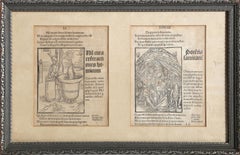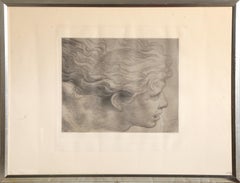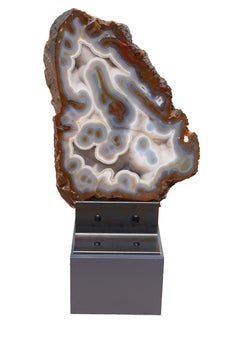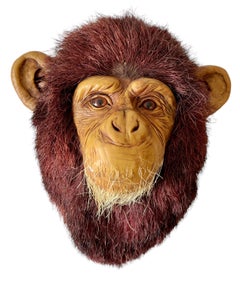RoGallery
to
8,328
6,120
2,801
2,352
1,958
1,119
644
573
386
345
272
251
244
178
149
113
106
80
56
50
47
44
33
21
13
11
4
3
3
3
2
2
2
2
2
2
1
1
1
1
1
1
Period: 15th Century and Earlier
Ship of Fools Diptych, Old Masters Woodcut and Engraving by Albrecht Dürer
By Albrecht Dürer
Located in Long Island City, NY
Albrecht Dürer, German (1471 -1528) - Diptych from First Edition of The Ship of Fools, Year: 1494, Medium: Woodcut and Engraving, Image Size: 7 x 12.25 inches, Frame Size: 10.75 ...
Category
15th Century and Earlier Old Masters Figurative Prints
Materials
Engraving, Woodcut
Heliodrorus, Old Masters Engraving after Raphael Sanzio da Urbino
Located in Long Island City, NY
Raphael Sanzio da Urbino, After by Alphonse Leroy, Italian (1483 - 1520) - Heliodrorus, Medium: Engraving, Image Size: 10.75 x 13.25 inches, Size: 19 x 25.5 in. (48.26 x 64.77 cm)...
Category
15th Century and Earlier Old Masters Prints and Multiples
Materials
Engraving
Large Geode with stand
Located in Long Island City, NY
This large geode is an intriguing sculpture with immense depth and contrasting textures.
Size: 31 x 25 x 5 inches
Size with base: 41 x 25 x 5 inches
Category
15th Century and Earlier Naturalistic Still-life Sculptures
Materials
Precious Stone
Related Items
French 19th century Animalier bronze of Two Hares on a naturalistic base
By Alfred Dubucand
Located in Bath, Somerset
19th century bronze group of a standing and sitting hare by French animalier sculptor Alfred Dubucand (1823-1894). Finely detailed bronze with good dark brown patination. Signature '...
Category
Late 19th Century Naturalistic Figurative Sculptures
Materials
Bronze
Monkey Head Natural Sisal Fiber Clay Sculpture Chimpanzee Anne Andersson Art
Located in Surfside, FL
Anne Andersson
Sisal fiber wall sculpture
Monkey Head (# 1)
Hand signed to verso
Dated 2009.
Measures approx. 11" height x 10" width x 6 1/4" depth.
Her sculptures are made of natural sisal Fiber from an agave and meticulously hand painted. The eyes are hand blown glass.
Anne Andersson was born in Gothenburg, Sweden, with a great desire to explore Nature and a Passion for Art. She received a degree in science in 1981 from Kjällbergska University in Gothenburg and a degree in Art from the Art Institute of Fort Lauderdale. She now works from her studio in St. Petersburg, Florida as a Sculptor, illustrator and painter. Her work calls to mind the animalia artworks of Henri Maik and Gustavo Novoa.
Anne Andersson's artwork serves as an homage to our planet’s charismatic and rare wild animals. Inspired by the majesty and beauty of exotic wildlife, and motivated by an urge to preserve them, Anne’s astonishingly realistic life-size sculptures capture the experience of seeing these animals up close without exploiting them. Her sculpted work using natural materials and clay, provides a humane alternative to big game trophy hunting and taxidermy.
She combines her talents in painting, tapestry weaving and illustration with an intuitive attention to the smallest detail to truly bring her sculptures to life. She has created lions, tigers, leopards, jaguars, cheetahs, bobcats, lynxes, pumas, panthers, elephants, rhinos, bears, water buffalo, bison, moose, wolves, coyotes and more—but she feels closest to the big cats. Anne graduated with honors at the Art Institute of Fort Lauderdale in 1989. It was then that she met Don Moore...
Category
Early 2000s Naturalistic Figurative Sculptures
Materials
Clay, Tapestry, Wood
H 11 in W 10 in D 6.25 in
The Golden Calf - Nuremberg Chronicle, (528 Years Old)
Located in Santa Monica, CA
NUREMBERG CHRONICLE, 1493
THE GOLDEN CALF (THE CALF OF GOD) 1493
Woodcut. from "Liber Chronicarum." Printed by Anton Koberger text by Hartmann Sc...
Category
15th Century and Earlier Old Masters Figurative Prints
Materials
Woodcut
BATHOS / Tail PIece
By William Hogarth
Located in Santa Monica, CA
WILLIAM HOGRATH (1767- 1764)
THE BATHOS / Tail Piece 1764 (Paulson 1989: 216 I/I Paulson 1965/70: 216 I/I)
Engraving Plate 12 7/8 x 13 3/8, sheet 17 ¾ x 18 ¾ Designed & Engrav’d by Wm Hogarth at left and Published according to Act of Parliam’t March 3, 1764 at right. Good condition on thick laid paper Small bit of tape on the left & right sheet edges small stan lower sheet edge all on recto.
This Hogarth’s last print is fascinating as it is prophacy about death.
Various institutions have interesting commentaries - to wit:
Chicago Art Institute: Hogarth created The Bathos toward the end of his life. It is considered one of the bleakest artworks of the 18th century because it depicts the Apocalypse without an afterlife. The Angel of Death even collapses in exhaustion after having destroyed the world. In his hand is an execution decree and around him lies a mass of broken objects.
Princeton: Hogarth’s last print, The Bathos,….. is filled with all manner of images denoting the end of life as we know it. Entry no. 216 in Ronald Paulson’s catalogue raisonne Hogarth’s Graphic Works, 3rd revised edition says “This print is the culmination of such pessimistic images . . . . [taking] his general composition, the configuration of objects, and some of the particular items, from Dürer’s engraving, Melancholia; but he also recalls Salvator Rosa’s Democritus in Meditation (which derives from Dürer’s print) with a scroll at the bottom of the etching: ‘Democritus the mocker of all things, confounded by the ending of All Things’ (Antal, p.168).”
Newfields (Indianapolis Museum of Art): Hogarth intended this engraving to serve as the tailpiece to bound volumes of his collected engravings and, appropriately, it proved to be his last engraving. Father Time has died and his last will and testament has been witnessed by the three Fates. He is surrounded by a landscape of death, decay, and ruin. Hogarth aimed this print at dealers in “dark” Old Masters paintings who promoted the idea that ruins evoked sublime feelings in viewers—a sentiment, Hogarth wrote, that was reducing the world to ruin.
British Caricature...
Category
1760s Old Masters Figurative Prints
Materials
Woodcut
Father Stefan Fridolin, "Schatzbehalter" (Treasury of the True Riches
Located in Fairlawn, OH
Father Stefan Fridolin, "Schatzbehalter" (Treasury of the True Riches of Salvation): The 30th Figure - Astrological Diagram with Scene of the Nativity
Woodcut, 1491
Unsigned, as issued
Published by Anton Koberger
Diagram has Zodiac signs on outer ring, planets in the lower registers, and Nativity in the center.
Condition: Very good for a 15h century woodcut, with the usual slight age stains
Sheet size: 11 1/2 x 8 1/4 inches
Wogelmut was the teacher of Albrecht Durer and employed young Durer in many project of the last decade of the 15th century.
Michel Wolgemut Biography
Wolgemut trained with his father Valentin Wolgemut (who died in 1469 or 1470) and is thought to have been an assistant to Hans Pleydenwurff in Nuremberg. He worked with Gabriel Malesskircher in Munich early in 1471, leaving the city after unsuccessfully suing Malesskircher's daughter for breach of contract, claiming she had broken off their engagement. He then returned to his late father's workshop in Nuremberg, which his mother had maintained since Valentin's death.
In 1472 he married Pleydenwurff's widow and took over his workshop;[3] her son Wilhelm Pleydenwurff worked as an assistant, and from 1491 a partner, to Wolgemut. Some consider Wilhelm a finer artist than Wolgemut, however he died in January 1494, when he was probably still in his thirties. Wilhelm's oeuvre remains unclear, though works in various media have been attributed to him.
Woodcuts
Michael Wolgemut, Danse Macabre, 1493
Two large and copiously illustrated books have woodcuts supplied by Wolgemut and his stepson Wilhelm Pleydenwurff; both were printed and published by Germany's largest publisher, the Nuremberger Anton Koberger, who was also Dürer's godfather. The first is the Schatzbehalter der wahren Reichthumer des Heils (1491); the other is the Historia mundi, by Schedel (1493), usually known as the Nuremberg Chronicle...
Category
15th Century and Earlier Old Masters Figurative Prints
Materials
Woodcut
Apollo, plate 11 from the series of The Gods in Niches
Located in Middletown, NY
by Jacopo Caraglio (after Rosso Fiorentino)
Rome: Carlo Losi, 1526. Engraving on cream laid paper, 8 1/2 x 4 3/8 inches, 215 x 110 mm), thread margins. In very good condition with a...
Category
17th Century Old Masters Figurative Prints
Materials
Laid Paper, Handmade Paper, Engraving
Curtis Jere Copper Toned Metal Tree Sculpture c.1970s
By Curtis Jeré
Located in San Francisco, CA
Curtis Jere Copper Toned Metal Tree Sculpture c.1970s
Tall and elegant tree sculpture by listed American artist Curtis Jere.
The tree is made from...
Category
Mid-20th Century Naturalistic Still-life Sculptures
Materials
Metal
Map of the World: An Original 18th Century Hand-colored Map by E. Bowen
Located in Alamo, CA
This is an original 18th century hand-colored map entitled "A New & Correct Chart of All The Known World Laid down according to Mercator's Projection" by Emanuel Bowen. It was published in 1744 in London in John Harris's "Navigantium atque Itinerantium Bibliotheca" or "A Complete Collection of Voyages and Travels". This highly detailed and colorful map depicts the world. as it was known in the mid 18th century. A majority of the northern and central portions of Canada and America are left blank due to the purity of knowledge at the time this map was published.
The map is embellished with four Compass Roses in the lower left, lower center, lower right and center, along with many rhumb lines. There a is a decorative title cartouche in the upper left. This colorful, attractive, historical and interesting 1744 map presents the entire world on Mercator's projection as it was understood in the middle part of the 18th century, before the landmark explorations of Captain’s Cook, Vancouver, Wilkes and others. It is an example of a nautical chart, a type of map that was designed specifically for use by mariners. The map is centered on the equator and includes both the Eastern and Western Hemispheres. The continents of North America, South America, Europe, Africa, and Asia are depicted, as well as various islands in the Atlantic, Pacific, and Indian Oceans. The map is laid out according to the Mercator projection, a type of cylindrical map projection that was developed in the 16th century by Flemish cartographer Gerardus Mercator. This projection has the advantage of preserving angles and shapes, making it useful for navigation. The map presents a paucity of inland detail, particularly for the Americas, but major cities, geographical landmarks, and regions are included. Ocean currents and Tradewinds are identified, as well as the magnetic declination lines or magnetic variance, which refers to the difference between true north and compass north. The continents are color coded, enhancing the beauty of this map. The three compass roses indicate the directions of the cardinal points.
The depiction of the western coast of America, the Pacific and Australia are interesting. There was very little exploration of Australia between the navigations of William Damper in 1699 and Tobias Furneaux in 1773. Most of the maps detail relies on the 17th century Dutch expeditions to Australia's western coast, by Abel Tasman and William Janszoon. Van Diemen's Land (Tasmania) and New Guinea appear connected to the Australian continent. New Zealand appears as a single landmass. North of New Zealand there is a landmass labelled 'Ter d' St. Esprit' which probably represents the New Hebrides Islands. This map precedes the accurate exploration of the South Pacific and east coast of Australia by Captain James Cook later in the 18th century. The map includes ‘Drakes' Port,' the site where Sir Francis Drake supposedly landed in 1579 during his 1579 circumnavigation of the globe. Here he claimed territory for England, restocked, and repaired his vessels. Drake named the region New Albion. The exact location of Drake's Port is a cartographic mystery. Drake's Harbor is believed to be in the region of San Francisco Bay, Bodega Bay, San Pablo Bay...
Category
Mid-18th Century Old Masters Landscape Prints
Materials
Engraving
Persia, Armenia & Adjacent Regions: A Hand-colored 17th Century Map by De Wit
By Frederick de Wit
Located in Alamo, CA
This colorful and detailed 17th century copperplate map by Frederick De Wit was published in Amsterdam between 1666 and 1690. It depicts the Caspian Se...
Category
Late 17th Century Old Masters More Prints
Materials
Engraving
H 23.5 in W 27 in D 1.325 in
The Death of Lazarus
By Hieronymus Wierix
Located in Fairlawn, OH
The Death of Lazarus
Engraving, 1593
Feria VI. Post Domin IIII
From: Evangelicae Historiae Imagines, Plate 76
Condition: Excellent
Sheet size: 9 7/8 x 6 1/8 inches
Reference: Referen...
Category
16th Century Old Masters Figurative Prints
Materials
Engraving
Ostiakes
By Cornelis de Bruijn
Located in Fairlawn, OH
Ostiakes
Engraving, 1718
From: Voyages de Corneille le Brun par la Moscovie, en Perse, et aux Indes Occidentales (French translation, 1718), Chapter XXI
The Ostyak are a member of an...
Category
1710s Old Masters Landscape Prints
Materials
Engraving
Bermuda: An Early 17th Century Hand-colored Map by Henricus Hondius
By Henricus Hondius
Located in Alamo, CA
This attractive and interesting map of Bermuda by Henricus Hondius in 1633 is entitled "Mappa Aestivarum Insularum, Alias Barmudas". It is based on a ...
Category
Early 17th Century Old Masters Landscape Prints
Materials
Engraving
Read More
Romare Bearden’s Humanity Infuses His Bright, Bold Art
Through collage, painting and printmaking, the artist foregrounded Black life in America in revolutionary new ways.
Chryssa’s 1962 Neon Sculpture Was Way ahead of the Art-World Curve
By working with lettering, neon and Pop imagery, Chryssa pioneered several postmodern themes at a time when most male artists detested commercial mediums.
7 Exciting Works by Female Artists from the RoGallery Auction
Prints by these modern and contemporary visionaries are relatively affordable — for now.



